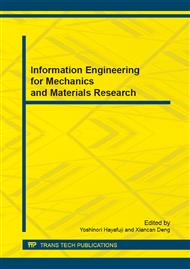[1]
S. Moyer, A. Umar, et al. The impact of network convergence on telecommunications software. IEEE Communications Magazine, 2011, 39 (1): 78–84.
DOI: 10.1109/35.894380
Google Scholar
[2]
D. Jiang., Z. Xu, L. Nie, et al. An approximate approach to end-to-end traffic in communication networks, Chinese Journal of Electronics, Oct. 2012, 21(4): 705-710.
Google Scholar
[3]
D. Jiang, Z. Xu, Z. Chen, et al. Joint time-frequency sparse estimation of large-scale network traffic, Computer Networks, Oct. 2011, 55(10): 3533-3547.
DOI: 10.1016/j.comnet.2011.06.027
Google Scholar
[4]
X. Wang, W. Du, and D. Zheng, A class of the wireless sensor networks QoS description and evaluation. In Proceedings of the 2011 Third International Conference on Measuring Technology and Mechatronics Automation (ICMTMA'11), Shanghai, China, Jan. 6-7, 2011, pp.16-19.
DOI: 10.1109/icmtma.2011.11
Google Scholar
[5]
M. Shangguan, X. Gong, W. Wang, X. Que, et al. A routing mechanism to support QoS of multi-class traffic. In Proceedings of 2010 International Conference on Advanced Intelligence and Awareness Internet (AIAI'10), Beijing, China, Oct. 23-25, 2010, pp.329-332.
DOI: 10.1049/cp.2010.0780
Google Scholar
[6]
Z. Abdeyazdn, M. Ardakani, and C. Tellambura, Reduced-overhead multicasting of different QoS data classes. In Proceedings of the IEEE Canadian Conference on Electrical & Computer Engineering (CCECE'12), Montreal, QC, April. 29-May. 2, 2012, pp.1-5.
DOI: 10.1109/ccece.2012.6334897
Google Scholar
[7]
H. Jin, H. Zou, F. Yang, R. Lin, and X. Zhao et al. QoS-based service selection for multiple requests with different classes. In Proceedings of the International Conference on Service Systems and Service Management (ICSSSM'12), Shanghai, China, July. 2-4, 2012, pp.604-609.
DOI: 10.1109/icsssm.2012.6252309
Google Scholar
[8]
Statovci-Halimi, B, Adaptive admission control for supporting class-based QoS. In Proceedings of the 2010 6th EURO-NF Conference on Next Generation Internet (NGI'10), Paris, France, June. 2-4, 2010, pp.1-8.
DOI: 10.1109/ngi.2010.5534474
Google Scholar
[9]
M. Renzo, L. Alonso, F. Fitzek, and P. Greenet, An early stage training network in enabling technologies for green radio. In Proceedings of the 2011 IEEE 73rd Vehicular Technology Conference (VTC Spring), May, 2011, pp.1-5.
DOI: 10.1109/vetecs.2011.5956211
Google Scholar
[10]
D. Jiang, Z. Xu, H. Xu, et al. An approximation method of origin-destination flow traffic from link load counts, Computers and Electrical Engineering, Nov. 2011, 37(6): 1106-1121.
DOI: 10.1016/j.compeleceng.2011.06.009
Google Scholar
[11]
D. Jiang, G. Hu. GARCH model-based large-scale IP traffic matrix estimation. IEEE Communications Letters. 2009, 13(1): 52-54.
DOI: 10.1109/lcomm.2008.081271
Google Scholar
[12]
H. Talbi, A. Draa, and M. Batouche, A new quantum-inspired genetic algorithm for solving the traveling salesman Problem. In Proceedings of the IEEE International Conference on Industrial Technology (ICIT'04), Dec. 8-10, 2004, pp.1192-1197.
DOI: 10.1109/icit.2004.1490730
Google Scholar
[13]
S. Antonakopoulos, S. Fortune, and L. Zhang, Power-aware routing with rate-adaptive network elements. In Proceedings of the 2010 IEEE GLOBECOM Workshops (GC Wkshps), Dec. 6-10, 2010, pp.1428-1432.
DOI: 10.1109/glocomw.2010.5700173
Google Scholar


